C'mon everybody:
How Eddie Cochran and Gene Vincent
changed British music for ever
The
Independent January 14, 2010 ~ By Spencer Leigh
In terms of popular culture, many commentators start the
Swinging Sixties with the Beatles in 1963, but the Sixties started swinging
in January 1960 itself with the UK's first rock'n'roll package tour featuring
the American stars, Eddie Cochran and Gene Vincent. Judging by reports
in regional newspapers by inappropriate theatre reviewers, the tour was
a Grade A disaster, but of course it wasn't. The audiences loved the shows
and more importantly, fledgling British musicians watched closely and determined
that this was the way forward. Considering there are now films about relatively
unimportant moments in rock history, it is inexplicable that there has
not been a film about Cochran and Vincent, especially when the story is
so colourful.
In 1956, the impresario Larry Parnes had catapulted Tommy
Steele to stardom as Britain's answer to Elvis Presley. Steele played along
for a while, but he was not threatening enough to be a Presley and his
records made with London jazzmen lacked Presley's commitment. As Steele
developed into a family entertainer, Parnes tried again with Marty Wilde
and Billy Fury, who were more committed to the new music.
The managers of the American rock'n'roll stars had been
reluctant to send their charges to the UK as there was more money to be
made in the US. Bill Haley had passed his peak when he visited in 1957;
and although Buddy Holly toured with success in March 1958, the rest of
the bill was end-of-the pier variety. Lew and Leslie Grade promoted Haley
and Holly but they came unstuck in May 1958 when a Jerry Lee Lewis tour
was cancelled after he revealed the age of his wife.
There never was a sweet Gene Vincent. In 1956, when he
was 21, the curly-haired boy from Norfolk, Virginia had stormed to success
with "Be-Bop-A-Lula", but his unpredictable behaviour alienated him from
his band, the Blue Caps, who complained to the union. By the autumn of
1959, he was banned from many States and reduced to playing small-time
dance halls with pick-up bands. His new manager, Norm Riley, thought European
dates were the answer as nobody would know of his problems. The TV producer,
Jack Good booked him for ITV's Boy Meets Girl and arranged a guest appearance
at Tooting Granada on Marty Wilde's stage show.
Gene was super-polite, saying "sir" and "ma'am" to everyone,
and performed very well. Parnes set up some tour dates with Wee Willie
Harris in January, while Good worked on his image. He loathed Vincent's
vivid green suit with "GV" on the pocket, but loved the intense way he
would gaze into the distance while he sang his songs. "Gene wore a leg
iron," he recalls, "so he hobbled a bit. I was a Shakespeare fan, so hobbling
to me meant Richard III. I even thought of giving him a hunchback, and
I'm glad I didn't! Then I thought, 'He can also be moody like Hamlet',
so we'll dress him in black from head to toe and put a medallion round
his neck."
Norm Riley suggested another artist to Good and Parnes:
Eddie Cochran. Cochran was a great-looking 21-year-old musician, who had
grasped the techniques of over-dubbing, often playing several instruments
on his records. His wittily observed commentaries on teenage life, "Summertime
Blues" and "C'mon Everybody", matched Chuck Berry's, but following Buddy
Holly's death in a plane crash in February 1959, he had been reluctant
to tour. Riley told him that once he got to the UK on a major airline,
there would be no flying. Indeed, most of the tour was by train and there
is a telling photograph of Brian Bennett, later with the Shadows, struggling
with his drum-cases on Bexhill Station.
Parnes set up a tour, mostly two houses a night, from
January 24 to April 16, a combination of complete weeks in the big cities
and one-night stands elsewhere. He completed the bill with his own artists,
Billy Fury, Joe Brown, Vince Eager and Tony Sheridan, as and when they
were available, and he secured valuable TV and radio publicity via further
appearances on ITV's Boy Meets Girl and the BBC Light Programme's Saturday
Club. This was the first 100 per cent rock'n'roll package to tour the UK
and advance ticket sales were good.
Marty Wilde met Cochran when he arrived on mid-January:
"The first thing I noticed about Eddie was his complexion. We British lads
had acne, and Eddie walked in with the most beautiful hair and the most
beautiful skin – his skin was a light brown, a beautiful colour with all
that California sunshine, and I thought, 'You lucky devil.'"
Cochran and Vincent would be backed by young British rock'n'roll
musicians, among them, 16-year-old Georgie Fame: "We were told to report
to this club in Soho to meet them. I remember Eddie playing guitar and
we were astounded. Apart from his own stuff, he could do all that brilliant
finger-style stuff that Chet Atkins did. Then he played this amazing intro
to "What'd I Say" and apart from a few blues enthusiasts who had the Ray
Charles record, nobody had heard it before. He played "What'd I Say" every
night and within six months, every band in the country was playing it."
In a couple of days, Cochran had turned the British youngsters
into a viable rock'n'roll band. "Eddie had a great trick," says Joe Brown.
"He put a second string instead of a third string on his guitar, so that
he could bend it and get those bluesy sounds that you never heard in England.
I nicked the idea and got lots of session work as a result."
The tour began at the Gaumont, Ipswich. Eddie said: "It's
great to be hear in Hipswich", and then gyrated his hips, thus milking
the screams. Cochran was an instant success but Vincent proved to be variable.
All his songs opened with "Wel-l-l-l-l" and it was touch and go as to whether
the band would pick up what was next.
"Gene liked me to crouch down so that he could swing his
bad leg over my head," says Joe Brown. "He was very accident prone and
at one stage he was in plaster up to his thigh. He swung his leg up in
the usual way, but caught me on the side of the head. It knocked me flat
and squashed my guitar."
As they toured the country, the reviews were appalling.
The Yorkshire Post described the tour as "a prolonged assault on the eardrums".
The Leicester Mercury said: "These 'singers' seemed to get enjoyment out
of leg-kicking, face-pulling and making the youngsters scream. I cannot
believe this is true entertainment. Why do these idiotic teenagers behave
in such a ridiculous fashion? "
Cochran, who, prior to the tour, had only known Vincent
casually, realised what a liability he was, a paranoid fantasist who needed
looking after. However, they were strangers in a strange land, not used
to cities that shut down at 10.30pm, no daytime or late-night TV and no
American comics.
The young British musicians were drinking occasional pints
of bitter and they were surprised to find Cochran and Vincent constantly
slugging Jack Daniel's from the bottle. They were wary of Vincent who,
if antagonised, would say, "Wanna meet Henry?" and pull out his switchblade.
One night, he cut up the road manager's suit... while it was still being
worn.
The guitarist Big Jim Sullivan remembers, "Eddie was so
drunk at the Liverpool Empire that we weren't sure that he would make it
to the stage. It had one of those microphones that came up from the floor.
We positioned Eddie so that it would come up between his body and his guitar
and he could balance on it."
One thing that kept Eddie Cochran happy was a succession
of girlfriends. After melancholy phone calls to a Hollywood girlfriend,
the songwriter Sharon Sheeley, he was surprised when she came to England
and joined the tour party. Parnes was very happy with the receipts and
persuaded Cochran to join Vincent for a further tour in late April. The
final week of the first leg was at the Bristol Hippodrome.
They were flying out on Sunday lunchtime from London airport,
and they decided to go to London after the final show in an unlicensed
cab. Speeding outside Chippenham, both Eddie and Sharon were singing "California,
Here I Come" as the car hit a concrete lamppost, and Eddie Cochran was
killed.
Monday's Daily Mirror led with the story, "Rock Star Dies
in Crash", but such was the antipathy towards youth culture that the accident
was not even highlighted in The Times.
The driver was fined £50. To be paid off at £5
a year.
Gene Vincent had been in a serious road accident, lost
a close friend and damaged his ribs. He returned to America but Parnes
brought him back within a fortnight for the second leg, now billed as a
tribute to Eddie Cochran. One booking was at Liverpool Stadium on May 3.
To replace Cochran, the bill was completed with local acts including Gerry
and the Pacemakers but not the Beatles as the promoter Allan Williams did
not consider them good enough. A few weeks later, Larry Parnes came to
Liverpool, heard them and booked them to back Johnny Gentle on a tour of
Scotland. British rock'n'roll was finding its own identity.
Parnes's tour with Gene Vincent collapsed at Theatre Royal,
Nottingham, after the singer read out a telegram which said his daughter,
Melody, had been killed. The audience laughed as they thought Vincent in
his mumbled, incoherent way was talking about a dog. Vincent flew home
to find his daughter was safe, which was always the case as he had sent
the telegram to himself.
Gene Vincent staggered on with increasingly chaotic gigs
and his wild personal life. He died in October 1971 of a perforated ulcer:
he was a destitute, confused, overweight, alcoholic and humiliated wreck.
He was buried in black leather in Newhall, California. After 15 nomadic
years, Gene Vincent was staying put.
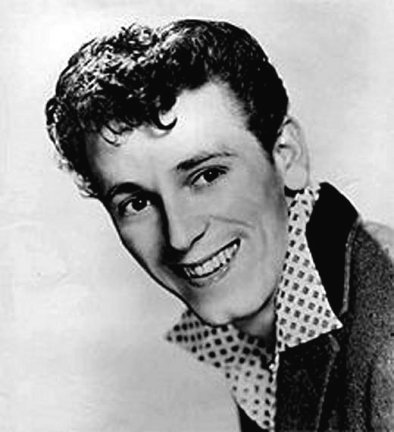
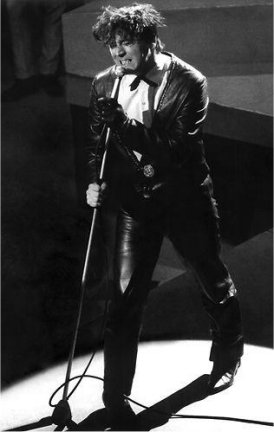


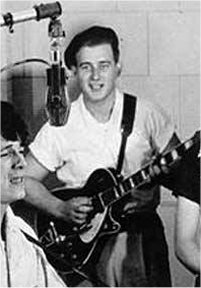
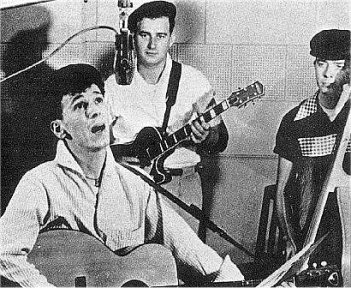
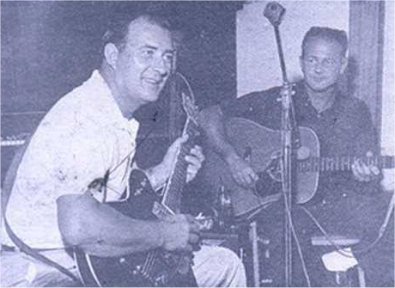
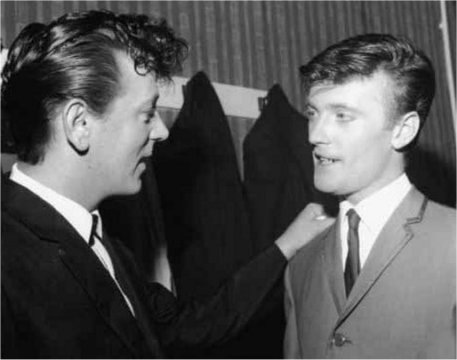 .
.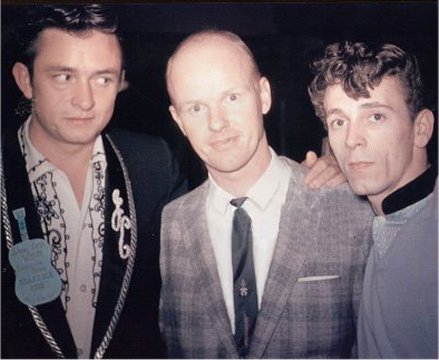
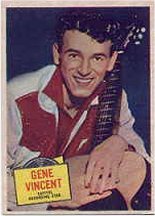
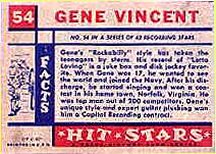
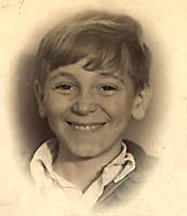
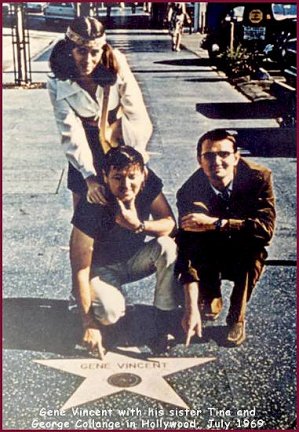
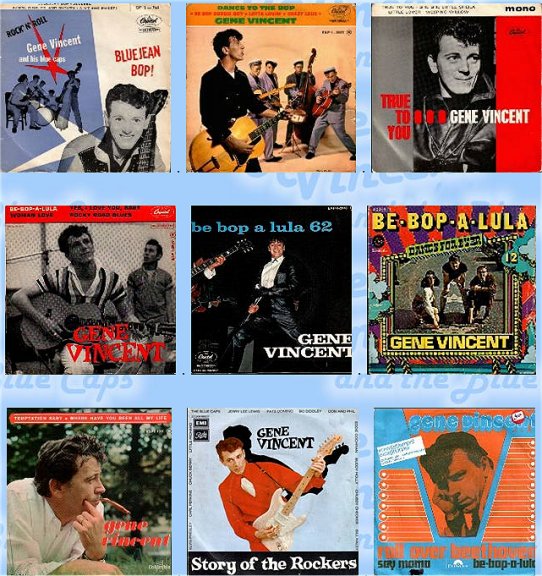
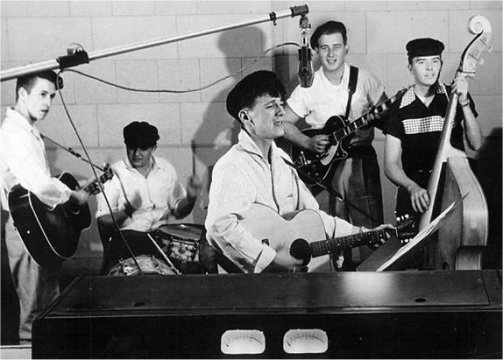
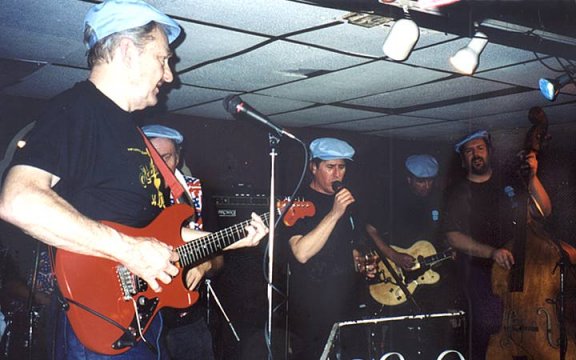
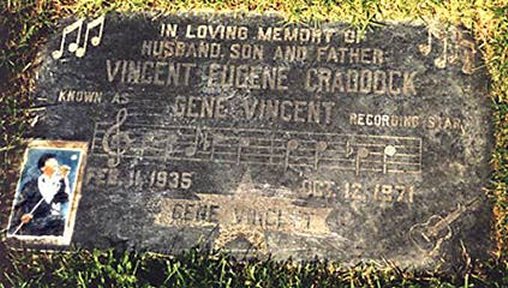
![]()
![]()
![]()